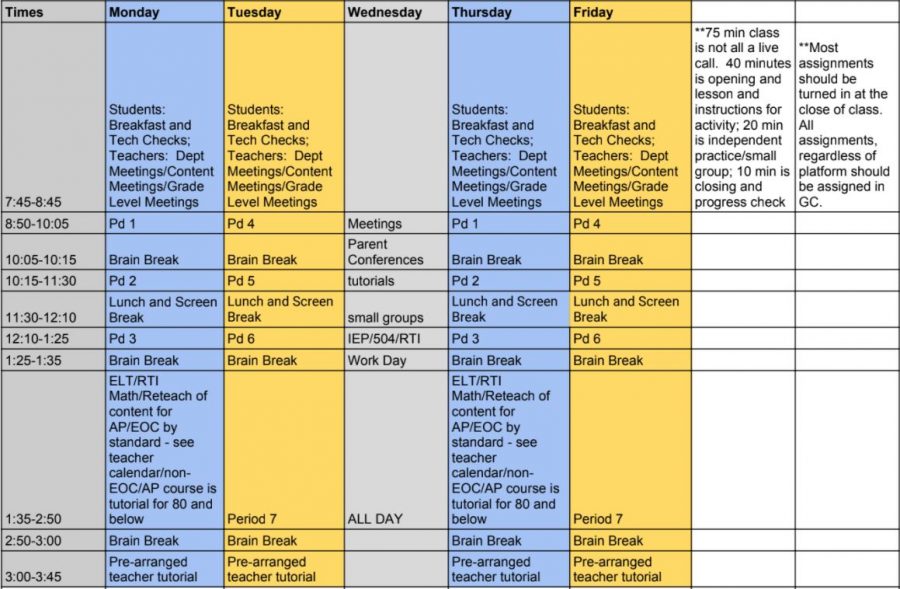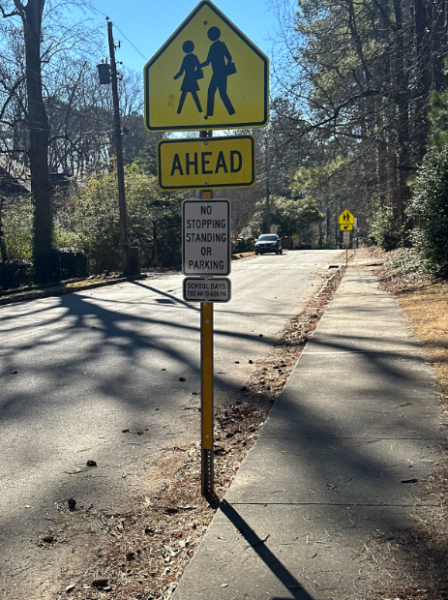The Long and Short of it: Chamblee’s Extended Second Semester Schedule
Schedule initially announced for second semester(now changed)
Editor’s note: In the time since this article was written, DCSD released its new plan for the second semester: lengthening the school day to a traditional 7-period schedule with a plan to return to in-person instruction in late January. Although this solves some of the dual enrollment scheduling issues mentioned below, it still involves extending daily virtual learning to a 6-hour time frame, which is a concern for many. Therefore, we found that the opinions expressed by teachers and students in this article, although directed at a now-outdated plan, are still pertinent and should be shared.
In early December, Chamblee High School’s administration announced that upon returning for the second semester, students and faculty will not see the same class schedule they have become accustomed to throughout these past five months, with 45-minute-long classes taking place over four hours and five minutes from 9:45 to 1:50. Instead, individual periods will be extended to 75 minutes, and as a result, the school day would lengthen, spanning 6 hours from 8:50 to 2:50, a nearly 50% increase in the length of the day. And while DeKalb has released their plans for a tentative return to in-person schooling beginning in late January, this schedule is what we’ll be seeing to start the second semester.
AP government and world history teacher Mattie Kaspar explained how she hopes this change will foster accountability in students.
“It’s intended to be a time management thing, which I think is what a lot of students struggled with in the very beginning,” said Kaspar. “Some students really need a teacher to be present with them and to say, ‘I need you to work on this exact assignment for 20 minutes. And at the end of that 20 minutes, I need to see a final product. If you don’t have that, let’s talk about why you don’t have that or what’s holding you back.’”
Kaspar noted that the new schedule is an effort to increase instructional time relative to nearby counties.
“I do understand the county’s need to kind of ‘catch up,’ because Cobb, Gwinnett, and I think Fulton are all doing full days,” she said. “And we just haven’t been.”
Literature teacher Hannah Postema described another potential purpose of the change.
“I think personally that moving towards this block schedule for next semester is so that when we go back face to face, and the vaccine is out, and everything’s kind of returning to […] normal, this is us putting a foothold in so that we can move the whole school to some sort of block schedule when we’re face-to-face,” she said. “And this is laying that groundwork.”
Postema also brought up the idea that the new schedule’s so-called “brain breaks,” combined with in-class student work time, could provide a much-needed planning period for some teachers.
“[Students will] be there on Monday and Tuesday and Thursday and Friday, and teachers will be there all five days. So, my planning [periods] are second and third periods. So on this schedule that we have right now, and that we’re sticking to, until something changes, I have no planning breaks on Tuesdays and Fridays. I just go all day,” she said. “And so those brain breaks are there for the kids. And they’re also there for teachers. I mean, at least that’s nice.”
However, students have noticed several potential problems with aspects of the extended schedule. One of the major concerns comes from Chamblee’s juniors and seniors who are dual enrolling.
James Hardy, a Chamblee senior who is taking classes at Oglethorpe University, says that the new schedule will overlap with his college classes.
“I set myself up to have an 8:00 to 9:30 a.m. class on Tuesdays and Thursdays. And then, […] they announced the new schedule […] in early December,” said Hardy. “And now we’re starting school way earlier; obviously it’s conflicting with my class, so every Tuesday I will be missing a lot of my fourth period.”
Fellow senior Shay Martin, who has experienced the same schedule conflict with his own Oglethorpe class, said that there isn’t an obvious way out of this predicament.
“There’s not really a fix I can do,” said Martin. “Like I can’t take a different class because the earliest classes Oglethorpe offers are at 8:00 a.m., so I can only take a late class, which will make me miss even more school.”
Hardy said that, because it’s too late to make scheduling changes at Oglethorpe, the only factor that can alleviate this problem is another change from Chamblee or the county.
“The deadline to drop classes for Oglethorpe was actually [the week of December 6]. So, we had probably about a week to decide if we were going to drop the current class, and then that week we weren’t sure if they were going to go through with the schedule or not,” said Hardy. “So, now we can’t change.”
Nolan Kurtzer, a senior dual enrolling at Georgia State University, discussed how this schedule change will affect a class that he needs in order to graduate.
“I’m taking a macroeconomics enrollment class next semester, and I need it to graduate. There’s only one class available at the Dunwoody campus, and it is from 8:30 to 9:45. If we had the original schedule, I would be stretching thin on Tuesdays, but I would still be able to make it work basically,” said Kurtzer. “But now with the new schedule, […] basically I would not be able to attend the first half of one of my classes. It’s more problematic.”
Chamblee students say they understand the problems that the new schedule was meant to solve, but they don’t think that this change was the right solution.
“[I heard] the reason that they’re extending the schedule was because a lot of freshmen and sophomores were doing poorly in their classes, and they were not adjusting well,” said Hardy. “I’ve heard from teachers that, by and large, seniors and juniors, who are kind of used to everything, are much better at managing themselves, which makes sense, they’re much more independent. But the solution we got was extending the period of the day so these younger students, who probably don’t have great attention spans in the first place, are probably paying even less attention to class, and having less time to themselves to unwind in what is a really, really stressful time.”
Lauren Vaughn, a junior, echoed this sentiment.
“A very large population of the student body is not logging into classes, they’re failing, all that stuff, but I personally think the schedule with increasing class times and making due dates […] during class time is not the answer at all,” said Vaughn. “Personally, I really like the flexibility that the schedule we had this semester gave me. And I just don’t see how this new schedule would really bring up grades. If anything, I feel like the schedule is really going to stress people out and make people have less motivation than they already do to get assignments done. [The administration is] putting a bandaid on your finger when your whole leg is cut off. It’s a solution, yes, but it is not the right one and it is not placed correctly at all.”
Like Vaughn, sophomore Hannah Stewart said that she doesn’t think longer classes will lead to more work getting done.
“Since they’re making the classes a lot longer, they’re probably doing it because people aren’t doing their work outside of class,” she said. “But I don’t think that’s really going to change it for people who aren’t doing their work in the first place. And it’s just kind of taking up the time of the people who are doing their work, you know.”
Instead, students think that the extended class time will just contribute to the already large amount of unused time in the school day.
“Most of my classes already […] end zoom calls like 10 minutes early,” said Martin. “So they’re adding another 30 minutes to zoom calls basically. So it’s just gonna be a lot more wasted time.”
Junior Matthew Tubbs agreed with this viewpoint.
“With our current system, only four of my seven teachers consistently have class go the whole period, and all four of those classes are AP,” he said. “In my other three classes, the meetings last [between] five to fifteen minutes each day before we’re given asynchronous assignments.”
Students also worry that extended classes will simply lead to teachers assigning more work to fill the time.
“A lot of students are overwhelmed already with school,” said sophomore Lauren Hill. “I think having them an extra [30 minutes] in class could potentially make that worse.”
Vaughn expressed concerns about a potentially inflated workload.
“I really think that teachers, when they do start this new schedule, are really going to […] either make assignments even more pointless than they already are or will make them more rigorous,” she said. “And I feel like breakout rooms will be used a lot more, which I know everybody hates, and I feel like the workload will increase, and the amount of time that we have to do it will decrease a lot since they’re due during class time. And I think it’s just going to stress everybody out.”
Postema acknowledged that teachers may take advantage of the extended schedule to fit in more instruction.
“In theory, teachers and students won’t be increasing their time active in the classroom, that should stay at 30 minutes, but we all know that there are going to be exceptions, there are gonna be times where we go over, especially with classes that are content-based versus skill-based. [Teachers] still have [end of course] milestones at the end of this year. They got stuff that they gotta get in because, unfortunately for some of those teachers, if […] the kids don’t do well on those tests, It doesn’t look so great for [them],” she said. “I do think it lends itself to teachers giving more work. Not in a vindictive way, but in a, ‘Oh gosh, there’s more time now. Here, do these two more things so we can cover more stuff this semester’ and that’s intentional because this is also a change that’s been asked for by the district.”
Postema summed up some of the flaws and benefits of the new schedule.
“In a sense, it could be better for some students. It could be better to have that life practice, time to consult with their teacher, but it can also lead to more work being put on them,” she said. “And I do worry about that.”
Your donation will support the student journalists of Chamblee High School Blue & Gold. Your contribution will allow us to print editions of our work and cover our annual website hosting costs. Currently, we are working to fund a Halloween satire edition.

Thomas Rice is a senior, and this is his second year on the staff. In five years he hopes to be celebrating a Hawks NBA Finals victory after graduating college. The movie that would best encapsulate his Chamblee experience is "Tall Girl", except instead of “Girl” it’s “Boy” and instead of being about himself it’s about Blue & Gold staff writer Adam Pohl.

Adam Pohl is a senior and this is his second year on the staff. One movie that describes his life is "I Am Legend." In five years, he sees himself graduating college and entering the workforce as one insignificant cog in the unrelenting machine of capitalism.










